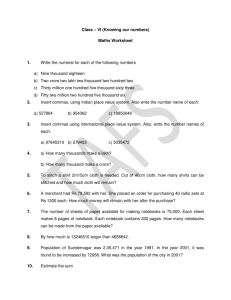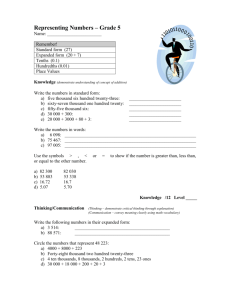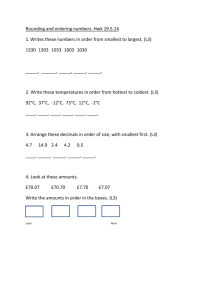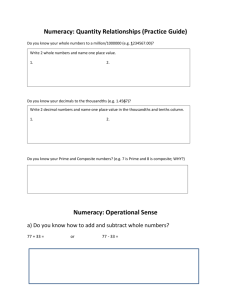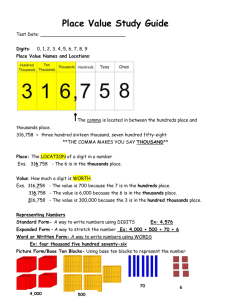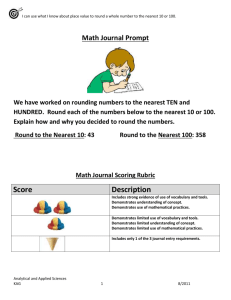Rounding 1 - Valencia College
advertisement
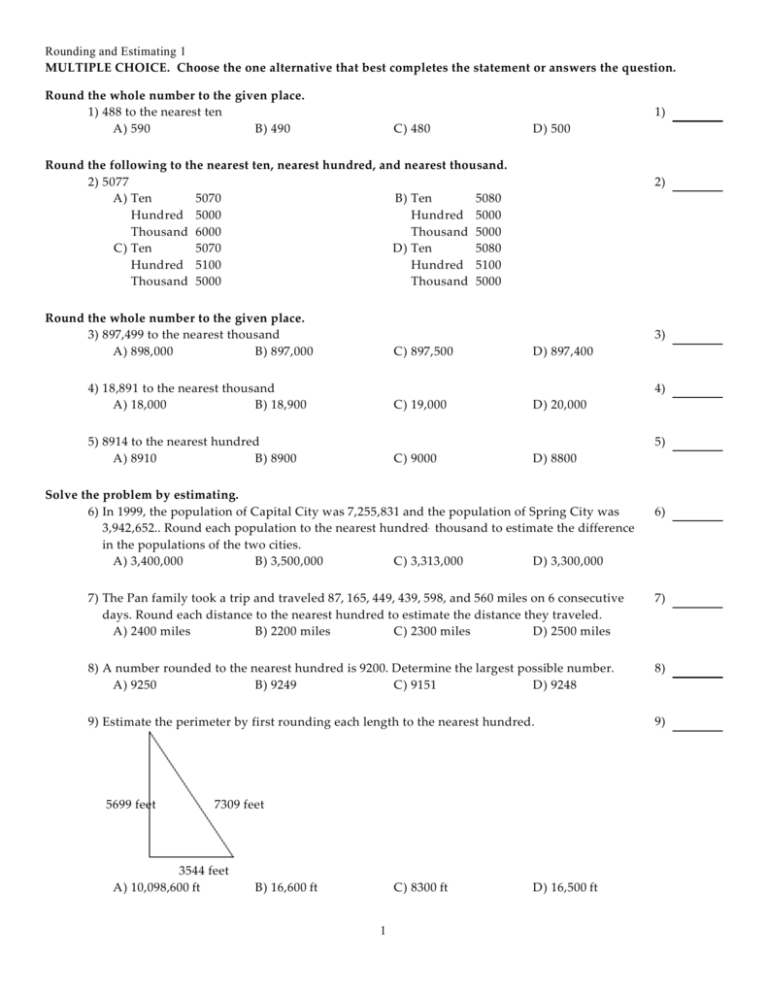
Rounding and Estimating 1 MULTIPLE CHOICE. Choose the one alternative that best completes the statement or answers the question. Round the whole number to the given place. 1) 488 to the nearest ten A) 590 B) 490 1) C) 480 D) 500 Round the following to the nearest ten, nearest hundred, and nearest thousand. 2) 5077 A) Ten B) Ten 5070 5080 Hundred 5000 Hundred 5000 Thousand 6000 Thousand 5000 C) Ten D) Ten 5070 5080 Hundred 5100 Hundred 5100 Thousand 5000 Thousand 5000 Round the whole number to the given place. 3) 897,499 to the nearest thousand A) 898,000 B) 897,000 2) 3) C) 897,500 4) 18,891 to the nearest thousand A) 18,000 B) 18,900 D) 897,400 4) C) 19,000 5) 8914 to the nearest hundred A) 8910 B) 8900 D) 20,000 5) C) 9000 D) 8800 Solve the problem by estimating. 6) In 1999, the population of Capital City was 7,255,831 and the population of Spring City was 3,942,652.. Round each population to the nearest hundred-thousand to estimate the difference in the populations of the two cities. A) 3,400,000 B) 3,500,000 C) 3,313,000 D) 3,300,000 6) 7) The Pan family took a trip and traveled 87, 165, 449, 439, 598, and 560 miles on 6 consecutive days. Round each distance to the nearest hundred to estimate the distance they traveled. A) 2400 miles B) 2200 miles C) 2300 miles D) 2500 miles 7) 8) A number rounded to the nearest hundred is 9200. Determine the largest possible number. A) 9250 B) 9249 C) 9151 D) 9248 8) 9) Estimate the perimeter by first rounding each length to the nearest hundred. 9) 5699 feet 7309 feet 3544 feet A) 10,098,600 ft B) 16,600 ft C) 8300 ft 1 D) 16,500 ft Rounding and Estimating 1 10) Enrollment figures at a community college showed an increase from 43,580 credit hours in 2005 to 89,292 credit hours in 2006. Round each number to the nearest thousand to estimate the increase. A) 45,800 credit hours B) 45,000 credit hours C) 46,000 credit hours D) 45,700 credit hours 10) Estimate the result of the calculation. Use your estimate to determine if the result appears to be correct or incorrect. 11) 195 + 520 + 677 + 381 = 1873 11) A) Incorrect. Estimate: 2000 B) Incorrect. Estimate: 1900 C) Incorrect. Estimate: 1800 D) Incorrect. Estimate: 1700 Estimate the sum or difference by rounding each number to the nearest ten. 12) 514 - 77 A) 400 B) 437 C) 430 12) D) 440 Estimate the sum or difference by rounding each number to the nearest hundred. 13) 8967 - 1449 A) 7518 B) 7600 C) 8000 13) D) 7500 Estimate the sum or difference by rounding each number to the nearest ten. 14) 6887 - 4774 A) 2110 B) 2113 C) 2100 14) D) 2120 Estimate the sum or difference by rounding each number to the nearest hundred. 15) 8866 + 1855 A) 10,800 B) 10,700 C) 11,000 2 15) D) 10,721 Answer Key Testname: 1.5ROUNDINGEST 1 1) 2) 3) 4) 5) 6) 7) 8) 9) 10) 11) 12) 13) 14) 15) B D B C B A C B D B C C B D A 3
